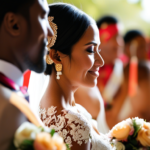The Magic of Traditional Wedding Ceremonies Around the World
Weddings are a universal celebration of love and commitment, but each culture brings its own unique traditions and rituals to the ceremony. From vibrant and colorful ceremonies to intimate and solemn rituals, traditional wedding ceremonies around the world offer a glimpse into the rich tapestry of global customs and beliefs. Let’s embark on a journey to explore some of the most enchanting and meaningful wedding traditions from different corners of the world.
In this article you will find:
- The Magic of Traditional Wedding Ceremonies Around the World
- Japanese Tea Ceremony
- Indian Saptapadi
- Mexican Lazo Ceremony
- Scottish Handfasting
- Nigerian Igbo Wine Carrying
- Conclusion
Japanese Tea Ceremony
Originating in Japan, the traditional tea ceremony, known as “ochakai,” holds a special place in Japanese weddings. The bride and groom prepare and serve tea to their parents as a symbol of respect and gratitude. This serene and elegant ritual emphasizes harmony and tranquility, reflecting the values of Japanese culture. The intricate movements and gestures involved in the tea ceremony convey a profound sense of mindfulness and reverence.
Indian Saptapadi
In India, the Saptapadi, or the seven steps, is a sacred ritual that symbolizes the journey of marriage. During this ceremony, the couple takes seven steps together, each step representing a vow they make to one another. From promising to support and cherish each other to pledging to nurture their future family, the Saptapadi is a deeply spiritual and emotional moment in traditional Indian weddings.

Mexican Lazo Ceremony
The Lazo ceremony is a beautiful Mexican tradition where a decorative lasso, or “lazo,” is placed around the shoulders of the bride and groom in the shape of an infinity symbol. This symbolizes the eternal bond of marriage and the unbreakable unity of the couple. The Lazo ceremony is often accompanied by prayers and blessings from the officiant, family members, and loved ones, making it a poignant symbol of love and commitment.
Scottish Handfasting
Scottish weddings are steeped in history and tradition, and the Handfasting ceremony is a timeless symbol of unity and devotion. During this ritual, the couple’s hands are bound together with a decorative rope or cloth, symbolizing their commitment and connection. As they exchange vows, the binding of hands signifies their pledge to support and care for each other throughout their lives.
Nigerian Igbo Wine Carrying
In Nigeria, the Igbo culture has a unique wedding tradition known as “Igba Nkwu,” or wine carrying. During this ceremony, the bride carries a cup of palm wine to present to her groom’s family as a gesture of acceptance and respect. The groom’s family then drinks from the cup to signify their approval of the union. This symbolic act embodies the spirit of community and acceptance in Nigerian weddings.
Conclusion
Traditional wedding ceremonies around the world are a testament to the diversity and beauty of global cultures. From intricate rituals to symbolic gestures, these traditions offer a glimpse into the values and beliefs that shape a couple’s union. Whether it’s the serene simplicity of a Japanese tea ceremony or the vibrant energy of a Mexican Lazo ceremony, each tradition adds a layer of meaning and significance to the wedding celebration. Embracing these cultural customs can not only make your wedding day truly memorable but also deepen the bond between you and your partner. So, as you plan your special day, consider incorporating elements of traditional ceremonies from around the world to create a truly magical and unforgettable wedding experience.

![Where can I find affordable wedding venues in [location]?](https://dreamdaychecklist.com/wp-content/uploads/2024/09/2f1b3024-bd90-4a9d-a411-643f1668ca5f_0-150x150.png)
